Hail Holy Queen, Hail Our Life, Our Sweetness and Our Hope!
Memorial of the Queenship of the Blessed Virgin Mary
What a beautiful salutation to call upon Our Most Blessed Mother! One may be tempted to think that these words are an exaggerated expression of piety as they apply also to her Son, whose sacrifice on the Cross obtained our Redemption.
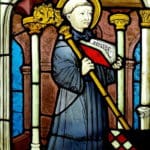 However, God’s Redemption began not with an imposition upon an unworthy humanity, but through the free gift of a woman’s fiat that first opened the door of heaven to bring down the Second Person of the Most Holy Trinity. This is why St. Bernard, and the Church throughout the ages echoing his words, refers to Mary as the “cause of our salvation”, for she is the instrument through which God entrusted His plan of Redemption to enter into the world – just as it was through Eve that Original Sin passed on from Adam to every generation.
However, God’s Redemption began not with an imposition upon an unworthy humanity, but through the free gift of a woman’s fiat that first opened the door of heaven to bring down the Second Person of the Most Holy Trinity. This is why St. Bernard, and the Church throughout the ages echoing his words, refers to Mary as the “cause of our salvation”, for she is the instrument through which God entrusted His plan of Redemption to enter into the world – just as it was through Eve that Original Sin passed on from Adam to every generation.
From the moment of her fiat to the Angel, Mary was inseparably bound up in God’s work of Redemption, both in its accomplishment and in the distribution of its merits. And she exercises these roles as the New Eve, acting as both Spouse of the New Adam (Jesus Christ) and His Mother. Her motherhood extends over both His earthly life, and in His Mystical Life prolonged in the Church – as Jesus made crystal clear on Calvary.
And as the mother of the King, she assumed a powerful role in the administering of His Kingdom – the distribution of graces which flow from the pierced Sacred Heart of Jesus to a world in desperate need of His Divine Mercy. So powerful and vast is her jurisdiction (as one might call it), that Jesus has entrusted to her the entire treasury of His graces. This is why the Church has called Mary the Dispensatrix and Mediatrix of all graces; for just as God found her worthy to be the woman in whom and through whom He would bring grace upon the world via the Incarnation and Redemption, so also does He continue His perfect way when 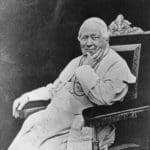 He distributes the merits of the Redemption, through Mary. The Church has hailed this singular prerogative of Mary from the earliest days of Christianity. In his encyclical Ubi Primum (1849) Blessed Pius IX summarizes the Church’s belief of this truth by making the famous teaching of St. Bernard that of the papal magisterium when he says:
He distributes the merits of the Redemption, through Mary. The Church has hailed this singular prerogative of Mary from the earliest days of Christianity. In his encyclical Ubi Primum (1849) Blessed Pius IX summarizes the Church’s belief of this truth by making the famous teaching of St. Bernard that of the papal magisterium when he says:
The foundation of all our confidence . . . is found in the Blessed Virgin Mary. For, God has committed to Mary the treasury of all good things, in order that everyone may know that through her are obtained every hope, every grace, and all salvation. For this is His will, that we obtain everything through Mary [St. Bernard, In Nativit. S. Mariae de Aquaeduct].
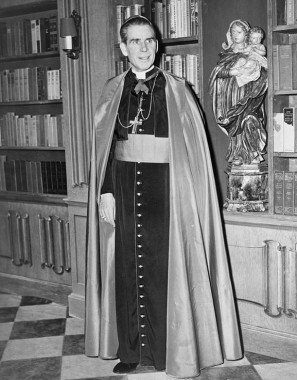 With these words, Blessed Pius IX provides a concise commentary on the first line of the Hail, Holy Queen highlighting why she is “our life, our sweetness and our hope.” At the same time he was launching the Church into the extraordinary Marian age in which we are living. An age in which we have seen the power of Mary’s Queenship over the cosmos as she demonstrated in Fatima on October 13, 1917 when she made the sun “her play thing,” as Venerable Fulton Sheen described it, before thousands of observers.
With these words, Blessed Pius IX provides a concise commentary on the first line of the Hail, Holy Queen highlighting why she is “our life, our sweetness and our hope.” At the same time he was launching the Church into the extraordinary Marian age in which we are living. An age in which we have seen the power of Mary’s Queenship over the cosmos as she demonstrated in Fatima on October 13, 1917 when she made the sun “her play thing,” as Venerable Fulton Sheen described it, before thousands of observers.
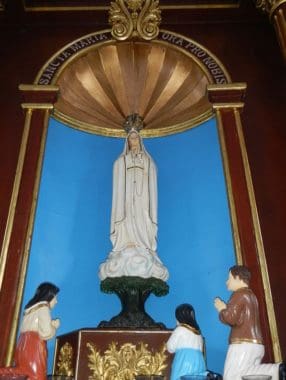 With the miracle of the sun at Fatima, one cannot help but think of Revelation 12 in which we see the heavenly reality underlying our current earthly battle, “A woman clothed with the sun, with the moon under her feet, and on her head a crown of twelve stars . . . and behold a great red dragon . . .” This is the real war we see being played out the in the world today . . . and in every human heart. That is why Mary, the Queen Mother of Jesus Christ, is being sent to us today. She is her Son’s last resort for a rebellious world, for nobody ever held the hearts of a king’s people more than a loving and solicitous queen.
With the miracle of the sun at Fatima, one cannot help but think of Revelation 12 in which we see the heavenly reality underlying our current earthly battle, “A woman clothed with the sun, with the moon under her feet, and on her head a crown of twelve stars . . . and behold a great red dragon . . .” This is the real war we see being played out the in the world today . . . and in every human heart. That is why Mary, the Queen Mother of Jesus Christ, is being sent to us today. She is her Son’s last resort for a rebellious world, for nobody ever held the hearts of a king’s people more than a loving and solicitous queen.
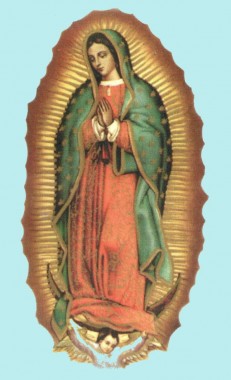 And she is very solicitous . . . and powerful . . . for wherever she is sent by her Son she obtains conversions by the hundreds of thousands. Wherever she is sent, she “crushes the head of the serpent” (Gen 3:15) and firmly establishes the banner of the Kingdom of God, with churches and basilicas erected and millions of new converts to fill them as the sign of her victory. Nowhere was this seen so vividly than in 1531 when she appeared in Guadalupe, Mexico. She left behind a heavenly imprint of Revelation 12 on the tilma of St. Juan Diego and through her powerful mediation, she obtained the conversion of over eight million Aztecs – basically a Pentecost a day for seven years!
And she is very solicitous . . . and powerful . . . for wherever she is sent by her Son she obtains conversions by the hundreds of thousands. Wherever she is sent, she “crushes the head of the serpent” (Gen 3:15) and firmly establishes the banner of the Kingdom of God, with churches and basilicas erected and millions of new converts to fill them as the sign of her victory. Nowhere was this seen so vividly than in 1531 when she appeared in Guadalupe, Mexico. She left behind a heavenly imprint of Revelation 12 on the tilma of St. Juan Diego and through her powerful mediation, she obtained the conversion of over eight million Aztecs – basically a Pentecost a day for seven years!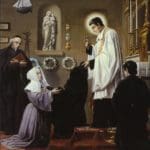
St. Louis De Montfort summarizes why this is the common Marian effect wherever she is sent and welcomed:
When the Holy Spirit, her spouse, finds Mary in a soul, he hastens there and enters fully into it. He gives himself generously to that soul according to the place it has given to his spouse. One of the main reasons why the Holy Spirit does not work striking wonders in souls is that he fails to find in them a sufficiently close union with his faithful and inseparable spouse . . . [True Devotion, 36]
Let us therefore open our hearts for the most gentle, yet powerful, of Mothers to carry into them the greatest gift, which she alone was entrusted to give to the world; the gift that makes Mary “our life, our sweetness and our hope” – the gift of the grace of Jesus Christ, which alone can transform and satisfy this deeply wounded and thirsting world.
Art: Coronación de la Virgen [Coronation of the Virgin], Diego Velázquez, ca 1645, PD-US author’s life plus 100 years or less; Stained glass representing St. Bernard of Clairvaux, unknown artist, ca 1450, PD-US author’s life plus 70 years or less; Pius IX, PD-US published in the U.S. prior to January 1, 1923; Fulton J. Sheen, 1952, “This photograph is a work for hire created prior to 1968 by a staff photographer at New York World-Telegram & Sun. It is part of a collection donated to the Library of Congress and per the instrument of gift it is in the public domain”; Our Lady of Fatima Parish Church of General Mamerto Natividad, 20 February 2013, own work Ramon FVelasquez, CCA-SA 3.0 Unported; Louis-Marie de Montfort with Marie-Louise Trichet, in the foundation of the Daughters of Wisdom congregation, unidentified artist, 19th c, CC-US author’s life plus 70 years or less; Holy Spirit Detail from Chair of Saint Peter in St. Peter’s Basilica, 03 05 2008, Sergey Smirnov, CCA-SA; Detail from Bridal Bouquet of Roses and Stephanotis Flowers, Jina Lee, 22 May 2004, CCA-SA 3.0 Unported; all Wikimedia Commons. Our Lady of Guadalupe, from various sources with minor variations, source unidentified.



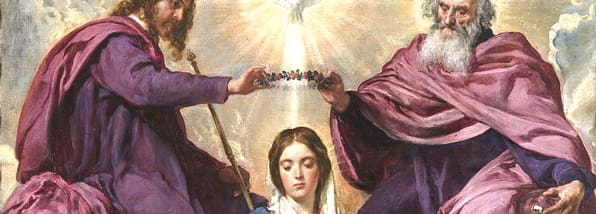
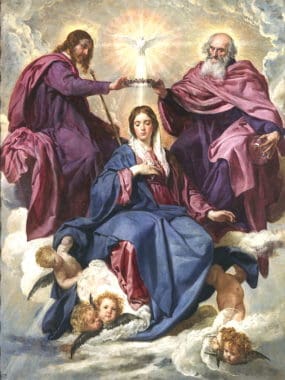
![BridalBouquetWhitePinkRoseStephanotis [wedding,marriage]](https://spiritualdirection.com/wp-content/uploads/2014/07/BridalBouquetWhitePinkRoseStephanotis-150x150.jpg)

